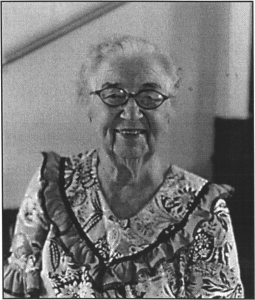Josephine Nelson Todd

Tsunamis Remembered: Oral Histories of Survivors and Observers in Hawai‘i
Life history interviews with individuals who witnessed and survived tsunamis-particularly the 1946 and 1960 disasters on the Big Island of Hawai'i. Thirty individuals-mostly residents of Hilo and Laupahoehoe-recall their experiences before; during, and after the 1946 and 1960 tsunamis which were arguably the most destructive natural disasters in modem Hawaiian history.
Josephine Nelson Todd was born November 9, 1906 in Pepe'ekeo, Hawai'i. She was the seventh of eleven children born to Hans Peter Nelson, an immigrant from Denmark, and Mary Morgado Nelson, an immigrant from Portugal. Hans Peter Nelson was an employee for Pepe'ekeo Sugar Company. When Todd was a young girl, the family moved to Hilo. She grew up in the Villa Franca section of Hilo, an area populated predominantly by Portuguese. Portuguese was Todd's flrst language. Todd remembers her many household chores, such as scrubbing floors with brushes made of coconut husks, and ironing clothes with a charcoal iron. She also remembers playing childhood games, such as kamapio and marbles, with the neighborhood children, and celebrating holidays with Portuguese and American foods. Todd attended St. Joseph's School from kindergarten through the eighth grade, then attended Hilo High School. Following graduation in 1924, she traveled to Honolulu to attend the Territorial Normal and Training School, receiving her teacher's certificate in 1927. Returning to the Big Island, Todd taught at 'Ola'a School, Kapi'olani School, and Waiakea Kai School before beginning a 34-year teaching career at newly-built Keaukaha School in 1930. In 1929, she married Oliver Todd, a Hilo native. The couple lived in a bungalow on the oceanfront, near the present-day Hilo Hawaiian Hotel. On April 1, 1946, the Todds' bungalow was destroyed by the tsunami, but they were able to save many of their belongings by removing these items from the home between waves. The Todds stayed at Josephine's mother's home in Villa Franca. Eventually, the Todds returned to the oceanfront lot to live. On May 22, 1960, after hearing the warning siren during the day, Josephine Todd went up to stay with her mother in Villa Franca, while Oliver Todd and their son, who was temporarily home from the U.S. Navy at the time, decided to stay in their oceanfront home. The next morning, the tsunami destroyed their home. The Todds managed to escape. Josephine Todd, left homeless by both the 1946 and 1960 tsunamis, was interviewed in her home on 'Iwalani Street. The area was set aside by the Hawai'i Redevelopment Agency for 1960 tsunami victims to purchase lots at low interest rates.
Scope and Content Note
A woman of Portuguese and Danish ancestry remembers her parents and home in Villa Franca, a neighborhood in Hilo. She recalls daily life--chores, meals, games, church. She attended St. Joseph's School and reminisces about meeting Queen Liliuokalani there. A Normal School graduate, she describes the then-new Keaukaha School and her students. She describes the destruction of her oceanfront home in both the 1946 and 1960 tsunamis.
Program Note:
This interview is part of the Center for Oral History's project Tsunamis Remembered: Oral Histories of Survivors and Observers in Hawai‘i. Interviews from this project are available in the Center's ScholarSpace open access repository.
The Center for Oral History (COH), in the Department of Ethnic Studies at the University of Hawaiʻi at Mānoa, collects, documents, preserves and highlights the recollections of Native Hawaiians and the multi-ethnic people of Hawaiʻi. It produces oral histories and interpretive historical materials about lifeways, key historic events, social movements and Hawaiʻi’s role in the globalizing world, for the widest possible use.
Please Note: The oral histories in this collection are protected by copyright and have been created for educational, research and personal use as described by the Fair Use Doctrine in the U.S. Copyright law. Please reach out Voices@noaa.gov to let us know how these interviews are being used in your research, project, exhibit, etc. The Voices staff can help provide other useful resources related to your inquiry.
The NOAA mission is to understand and predict changes in climate, weather, oceans, and coasts, to share that knowledge and information with others, and to conserve and manage coastal and marine ecosystems and resources. The Voices Oral History Archives offers public access to a wide range of accounts, including historical materials that are products of their particular times, and may contain offensive language or negative stereotypes.
Voices Oral History Archives does not verify the accuracy of materials submitted to us. The opinions expressed in the interviews are those of the interviewee only. The interviews here have been made available to the public only after the interviewer has confirmed that they have obtained consent.
